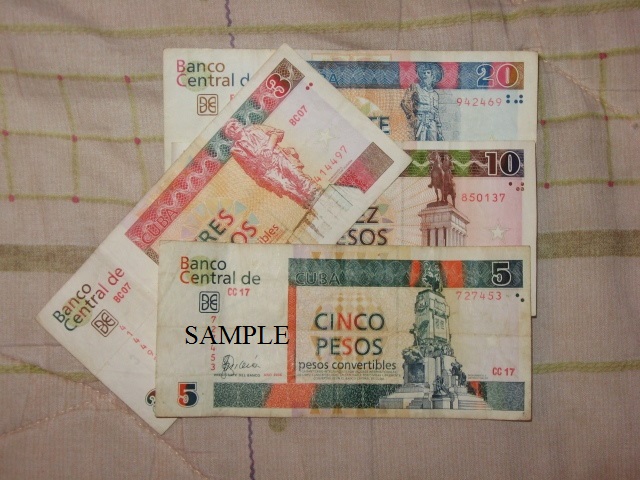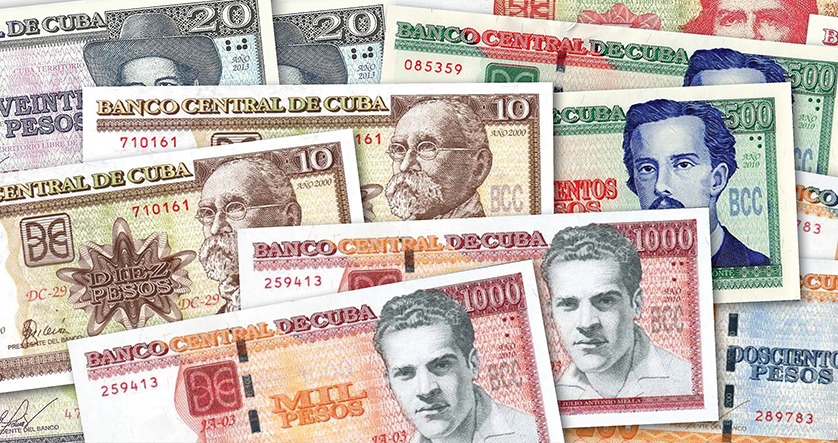
Updated May 2022
This article is for independent travellers in Cuba. People staying at all-inclusive beach resorts will not need to use Cuban currency except for buying souvenirs or a drink in a local restaurant outside the resort or using the bus or taxi. Debit and credit cards are customary at major hotels, stores, and restaurants at tourist resorts but not in other parts of the country. Some all-inclusive resorts do not accept Cuban currency at all. You must pay with a credit card or cash in one of the accepted currencies (see below). Not U.S. dollars, although some individuals such as maids and bartenders will gladly accept U.S. dollars.
Cuban Currency

Before travelling to any foreign country, I always recommend that you go to your local bank and order some currency for the country you intend to visit. This will be handy for a taxi from the airport and not dealing with currency exchange while lugging a suitcase. Depending on the country, this might take a couple of weeks, but your bank should be able to get it for you – except for Cuba. Cuban currency is not traded internationally, and you cannot buy any in advance. This is just the first of many problems you will encounter.
At the Airport
You will need some cash, and your first stop after clearing customs will be the currency exchange, where you will probably wait in line for about 30 minutes or more. (Everything in Cuba operates in slow motion). Get enough to take a taxi to your hotel (about $25), a meal, and your first night’s lodging. (More if it is a weekend or holiday and the banks are closed).
Mythatchedhut Travel Tip
Currency Exchange offices at the airport do not accept American cash or credit cards, or debit cards.
The Cuban Peso (Moneda National)
The Cuban Peso (abbreviated CUP) is the current Cuban currency. You will need a lot of cash as very few places in Cuba accept debit or credit cards. Keep most of your money hidden under your clothing and keep only what you need for the day in your pocket.
Moneda Libremente Convertible
The second payment method is the Moneda Libremente Convertible (abbreviated MLC). This currency does not exist with paper bills. It is only available on a particular type of prepaid bank card. You can purchase these cards at Banco de Credito y Comercio (BANDEC) or Casas de Cambio (CADECA) (official money exchange offices). The card costs the equivalent of five U.S. Dollars. You can then load several different currencies into the card. Accepted currencies are euros, pounds sterling, Canadian dollars, Swiss francs, Mexican pesos, Danish kroner, Norwegian kroner, Swedish kroner and Japanese yen. Not U.S. dollars or any other currency except these.
You can get unused money back from your card at a bank but only in Cuban Pesos. If you deposit Euros and don’t use them all, your refund will be in Cuban currency, which is worthless in other countries.
The MLC card is for tourists only. Not for use by residents of Cuba. It is accepted only in government-owned stores called “Tiendas MLC”. Not in privately owned shops. Tiendas MLC sells only expensive high-end items. They also accept most credit cards except those issued in the USA.
Keep track of how much money remains on your card. It is possible to check this at a bank, but that is time-consuming.
The benefit of using this card or cash is that it does not affect your home bank account like a debit or credit card would if lost or stolen.
Unless you plan to shop at the Tiendas MLC, don’t bother getting this card.
Be Aware of Obsolete Currency
The Cuban Peso is new as of January 2021. The previous currency, the Cuban Convertible Peso (abbreviated CUC) is now obsolete.
Learn to recognize the new currency and do not accept change in the old, obsolete bills. The old Cuban Convertible Peso is shown above.
Banking
Banking in Cuba is not a simple matter as it is in other countries. The preferred currencies are the Canadian dollar, British pound or the Euro. This is because the exchange rates are exceptionally high. You will probably lose about ten cents more per dollar than if you exchanged money in another country. The banks are all owned by the government and this is another of the dozens of methods of getting more money from tourists. Many other currencies are invalid, such as Australia, New Zealand and others.
Some debit and credit cards will work, and others will not. Canadian and European debit and credit cards with VISA will work. Don’t rely on a Mastercard debit card as your only source of money. In some places, they are accepted and not in others. Same for Mastercard credit cards. I found some banks that would not accept them and others that would.
Some banks (smaller ones) do not have the equipment to read the cards. I recommend travelling to any country with one Visa and one Mastercard credit card in case one is lost or stolen or, in the case of Cuba, simply not valid. Within any given bank, you might find only one teller that can give cash from a credit card. The other tellers may not have the necessary equipment to do this. Therefore, you may have a long wait. Debit and credit cards from banks in the United States, Australia, New Zealand and many other countries are not valid in Cuba.
Which Cards and Currency to Bring
Mythatchedhut Travel Tip
Bring some cash in Canadian Dollars, Euros, or British Pounds. Not U.S. dollars. Most other currencies are not good in Cuba. Bring a credit card with Visa. Mastercard is not accepted at most banks. Debit cards are not accepted in most places. This applies to travel outside of the tourist resorts. At major all-inclusive tourist resorts, they will accept most credit and debit cards. Don’t bring cash or cards in U.S. dollars.
Mythatchehut Travel Tip
In Havana, to get cash from a credit card, use a bank machine or go to one of the large banks on O’Reilly Street. The bank on the Prada does not accept credit or debit cards inside the bank, only at the bank machine outside. To exchange money or get cash from your credit card, you will need to have your passport and the address of the place you are staying.
Most hotels, stores and restaurants accept cash only. However, you can pay with credit cards at all tourist resorts.
Changing Currencies
Using a bank machine has a fee of about $5.00 U.S., plus your bank in your home country will also charge you a fee which could add up to about $10 Canadian each time you use a machine. There is also a huge fee of $6.72 U.S. for getting cash from a credit card (plus a cash advance fee of about $5 from your own bank plus interest on cash advances until you pay it back). Bank fees in Cuba will add a considerable amount to the cost of your trip. The only way around this is to arrive with sufficient cash to avoid using bank machines or credit cards. You will lose a lot when you exchange your money for CUC. There is no suitable method, but some are more expensive than others.
Mythatchehut Travel Tip
Change your money only at a bank or an official money exchange booth (called Casa de Cambio in Spanish). If you change money at your hotel you will probably pay a much higher exchange rate. If you change money in the street, you risk getting cheated, receiving convertible pesos instead of the new pesos or even counterfeit currency.
For Australians and New Zealanders
As Australian and N.Z. currencies are not accepted, you will need to exchange some money into one of the accepted currencies before you leave home, which must be changed into CUC in Cuba, creating an additional expense. Also, your credit and debit cards will not work, so you should open an account with a British bank.
There are no Australian or N.Z. embassies in Cuba. Therefore, if you have problems, New Zealanders should go to the British Embassy and Australians to the Canadian embassy, where they will try to help you with government problems.
I did not meet any tourists in Cuba from Australia or N.Z., so it seems this is not a popular tourist destination for people from these countries.
Traveller’s Cheques
Traveller’s Cheques are no good in most places and are more trouble and expense than they are worth. So please don’t bother with them. If you decide to use traveller’s cheques, get Thomas Cook or some other non-American brand. American Express is useless anywhere in Cuba.
Don’t Get Stranded
I met one person who had financial problems. He had two credit cards; one drawn on an American bank and the other on an Australian bank (he was Chinese). Although he had two good credit cards, neither worked in Cuba, and he was running out of money. So make sure that you will have access to sufficient funds for your trip.
When you leave
As you get near the end of your holiday, budget your Cuban currency so that you do not have too much leftover when you leave. Unless you plan to return to Cuba, exchange all your extra money at the airport. Cuban currency is worthless outside of Cuba, and no bank will give you anything for it. If you plan to return to Cuba in the near future, it might be handy to have some currency to go directly from the airport to a taxi and avoid the hassle of exchanging money at the airport.
Mythatchedhut Travel Tip
Cuban currency is not accepted at Cuban airports once you have passed security. However, it is, of course, good in the public area of the airport.
All fees and exchange rates are subject to change daily in any country.
In Conclusion
Except for big tourist resorts, Cuba is still a cash-only economy. I talked with people in a small village who had never seen a credit card or a computer.
This is the first of several posts about travel in Cuba. Use Mythatchedhut for all the information you will need to plan your trip to this beautiful but sometimes frustrating country.